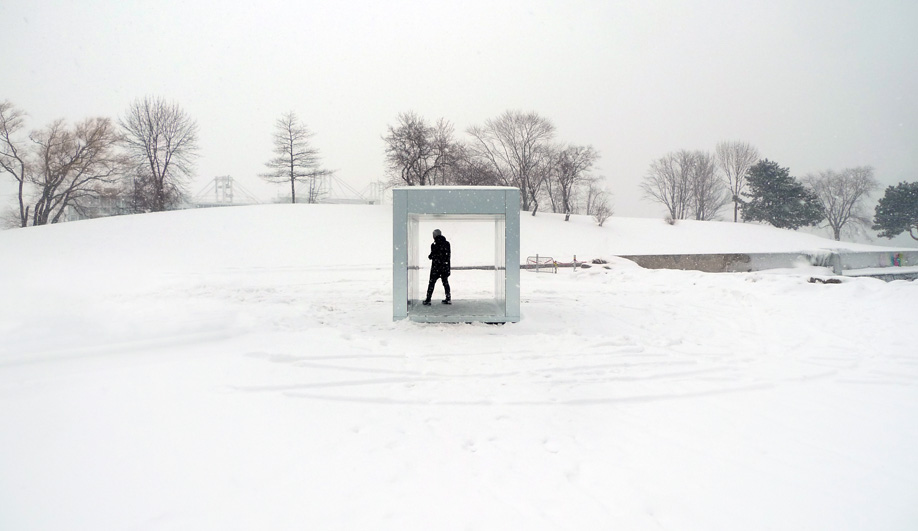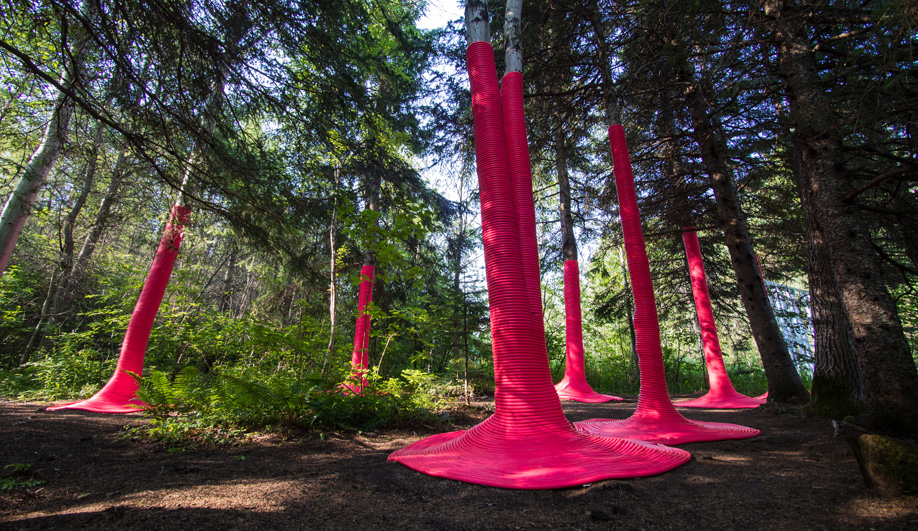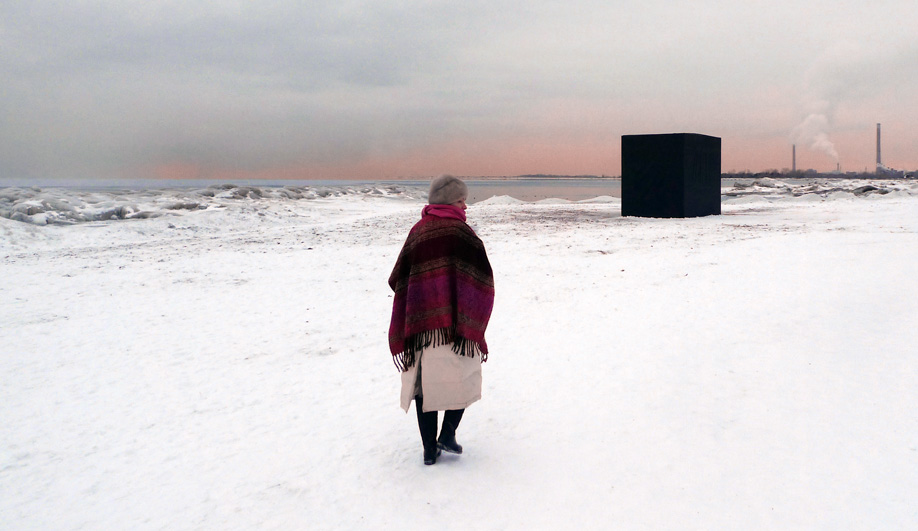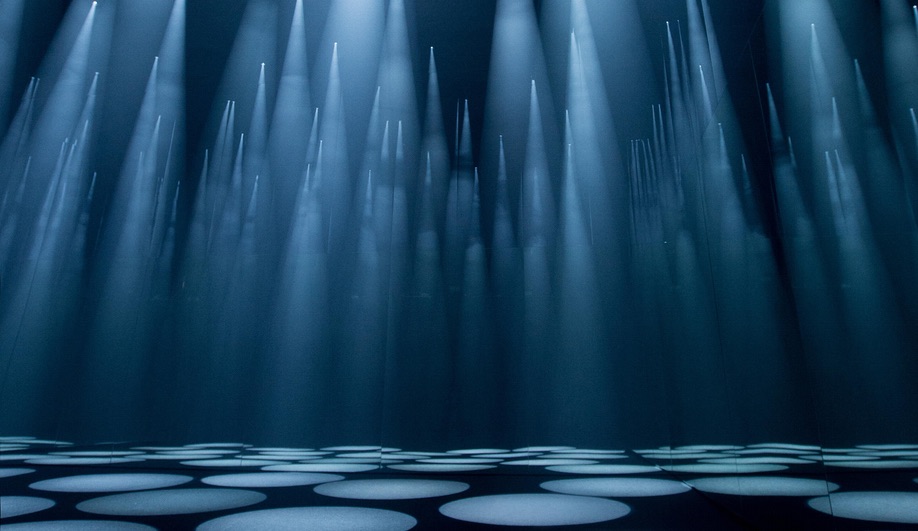
Toronto firm Polymétis found its niche by exploring the surprising potential of winter landscapes.
Against the dreary landscape of Toronto in February, and even the shimmering backdrop of Lake Ontario, Expanded Horizon almost disappears. A plain box of frosty-looking aluminum sheeting, open at both ends, the installation is about the same size (and temperature) as a meat locker. But look through its mirrored interior, and the distant cluster of skyscrapers to the west is suddenly transposed, Atlantis-like, to the middle of the lake. In a few hours, the box will frame the setting sun, and the ceiling will come to life with a soft, beckoning glow.
The work is the third in a series of temporary cubic structures by Polymétis built from off-the-shelf materials, all located just steps from the frozen waterfront. It follows 2015’s HotBox—a soundproofed black monolith that looked downright otherworldly against a backdrop of falling snow—and 2017’s IceBox, which presented the same featureless black façade, but hid a brilliant, wide-open courtyard filled with snow and ice. All three sit at the intersection of sculpture and architecture, and demonstrate the playful way Polymétis conceives of forms in unique relationship to their landscapes—especially winter ones.
Led by Michaela MacLeod, who teaches at the University of Toronto and the University of Waterloo, and Nicholas Croft, an architect with Toronto firm MJMA, Polymétis borrows its moniker from a 1755 book; the name roughly translates to “many trades.” It’s a fitting handle for a duo that, despite a penchant for constructing boxes, refuses to fit into one.
Backstory
In hindsight, MacLeod and Croft’s career trajectories both seem to be unwavering: Kids drawn to art and science became high school students already sure of their calling in architecture. But several degrees later, both were still looking for a niche. “I had done terms in architecture, and worked for two urban design firms in Toronto,” MacLeod says. “Then I moved to New York and worked at a landscape architecture firm. I tried everything I could potentially do with my degree.”
Croft, also in New York, was working under land artist Maya Lin. “That was eye-opening,” he says of the experience. “She was doing work that straddles the line between architecture, landscape architecture and, sometimes, just pure art. To watch her work and learn how she thinks was a big moment for me.”
Another big moment came in 2012, when Croft responded to MacLeod’s Craigslist ad seeking a roommate to share her East Village apartment. Just weeks after Croft moved in, the two were teaming up to create Pink Punch, an installation for a forest clearing in the Jardins de Métis, in Quebec. The following spring they headed north to construct the piece for the venue’s International Garden Festival. “They have these beautiful little cottages on the river where you stay,” MacLeod says. “You work hard all day building your thing, and then you get to meet the other artists at night. It’s a great experience.”
Unveiled in June of 2013, the sculpture consisted of little more than trees wrapped with fluorescent pink surgical tubing, but the effect was spectacular, as if the trunks were coated in goo that oozed across the forest floor. “Pink Punch was all about coming across a very bright, alien thing that draws you through the green of the forest,” Croft says. The highly photogenic project was a success, and spurred the establishment of Polymétis.

Tipping Point

“These projects were so small that we were able to really investigate the threshold of each one,” MacLeod agrees. “In IceBox, we explored compression and expansion.” Expanded Horizon’s mirrored interior, meanwhile, multiplies the sun when it’s needed most.
It’s no coincidence that all three boxes debuted in winter; they make the most of the surrounding greyness by maximizing contrast between light and dark, enclosed and open. “Winter can be brutal,” Croft says. “We’re trying to highlight some of the things that we think are beautiful about it.”
Polymétis hit its stride in the latter half of 2017, as several of its proposals were picked up within a matter of weeks: Expanded Horizon; sun-SET, a series of tree-wraps that superimposes a saturated sunset over the snowy streets of Mississauga, Ontario; and Lit, a glowing pink Christmas tree assembled from mirrors and prisms, which brought a dash of synthwave to the 12 Trees exhibit at the Gardiner Museum in Toronto. All three were unveiled by early December. The firm also won the call for a pavilion in West Cambie Park in Richmond, B.C.—their first permanent public installation.
What’s Next
The West Cambie pavilion is a major departure. The proposal is for a towering tripod of parametric curves constructed from interlocking timber beams, as if the landscape itself were bursting upward. A translucent sunshade sits on top, funnelling rainwater into an on-site estuary. “It’s a piece of art that’s also sustainable infrastructure,” says Croft.
The pair expects the larger scale of the project to open more doors. They’ve already been shortlisted for another permanent public installation in Guelph, Ontario. “We enjoy small projects—a lot of the way we think is at that scale—but we would love to explore some of those concepts in larger forms,” Croft says. “A museum or gallery would be pretty amazing. But as long as we can work on varied projects, we’ll be happy.”
Selected Projects
2013 Pink Punch, Jardins de Métis, Quebec
2015 HotBox, Winter Stations installation, Toronto
2015 Razzle Dazzle, Nobleton, Ontario
2016 My Chemical Garden, Grow-Op exhibtion, Toronto
2017 IceBox, TO IceBreakers installation, Toronto
2017 Lit, 12 Trees exhibtion at the Gardiner Museum, Toronto
2017 Expanded Horizon, Winter Light Exhibition, Toronto
2017 sun-SET, Mississauga, Ontario
2018 West Cambie Park, Richmond, B.C.
Nicholas Croft
Birthplace: Fort Rucker, Alabama
Education
2005 Bachelor of Architecture, University of Washington
2008 Master of Architecture, Rhode Island School of Design
2012 Master of Architecture in Urban Design, Harvard Graduate
School of Design
Awards
2008 American Institute of Architects Henry Adams Medal
Michaela MacLeod
Birthplace: Moncton, New Brunswick
Education
2002 Bachelor of Environmental Studies, University of Waterloo
2005 Master of Architecture, University of Waterloo
Awards
2005 Ontario Association of Architects Guild Medal Award
2007 Prix de Rome in Architecture for Emerging Practitioners



